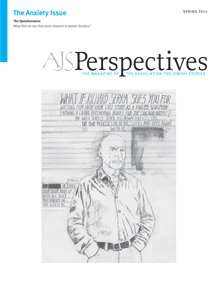Dear Colleagues,
AJS is still unpacking and absorbing the findings of its Survey of the Field, conducted in the fall of 2014 by Professor Steven M. Cohen. The purpose of this survey was not only to give students, scholars, administrators, and donors a nuanced sense of the state of the field, and the professional lives of scholars in the field, but also to help AJS chart its own course over the next several years. Taking the pulse of the Jewish Studies community would be important under any set of circumstances, but it has assumed a particular sense of urgency in what feels like a never-ending period of dramatic change in higher education. This change is by no means all bad: we are witnessing a revolution in teaching, scholarship, and publishing unleashed by new digital technologies, which have the potential to improve access to knowledge, data, students, and audiences on a scale never before possible. We are also seeing a new emphasis on teaching and learning outcomes, which is elevating the status of pedagogy and the classroom experience, to the great benefit of professors and students alike. Part of AJS's duty is to help its members navigate new opportunities as well as push the field along in uncharted areas, whether by providing a platform at the AJS Annual Conference for members to explore new frontiers, or (even better) to provide funding to members to experiment with them on their own campuses.
Another way AJS needs to respond to this period of great change pertains to the changing demographics of our membership. AJS's survey response rate was a remarkable 60%; of the 3,026 current and former AJS and ASSJ (Association for the Social Scientific Study of Jewry) members who received the survey, 1,790 responded. Of these, 71% self-identified as academics, either working or retired, 11% as students, and the remaining 18% of respondents listed a range of other professions, including researcher (6%); nonprofit professional (3%); museum/archive/library professional (2%); K–12 teacher/administrator (1%); and other (6%). (Interestingly, a 2008 survey of the AJS membership yielded 13.2% members who defined their status as something other than academic or student.)
While one might look at the statistics and think this is a relatively small percentage of the AJS membership, it's very likely that the actual numbers of Jewish Studies PhDs who have moved into careers outside of the professoriate is higher, and a priority of AJS is to prove a meaningful home for these scholars' professional needs and interests. For instance, AJS has restructured its membership dues, conference registration fees, and travel grant opportunities in a way that recognizes scholars working outside of colleges and universities and encourages their ongoing participation. Our dues are income based, and our travel grant programs favor those who do not receive institutional support for conference travel.
So, what would an AJS even more inclusive of a range of professions look like? A high priority is making sure to appoint even more members in a range of careers to AJS leadership roles, including key committees beyond the board. Ensuring that the language of our own communications do not present such career choices as second best is equally important (to cite an oft-repeated 2011 article by the AHA's executive director, James Grossman, and past president, Anthony Grafton, "No More Plan B"). Indeed, at this time when great emphasis is being placed on the public humanities, Jewish Studies PhDs who are assuming roles in museums, libraries, archives, philanthropies, and nonprofits are playing a critical role in demonstrating the very applicability of humanities- and social science-based training across a range of professions. AJS can also work to convey to advisors how critical a role they play in legitimizing to their graduate students career choices outside the professoriate. In my conversations with graduate students and recent PhDs, several express the frustration that they lack guidance on how to navigate beyond a traditional tenure-track trajectory, and do not think their advisor would approve. Lastly, AJS can help to mentor those who wish to explore this route, especially through special workshops at the annual conference that explore such topics as how to convert an academic cover letter and CV into a more generally usable resume, and also how to interview.
What else can we do? Please let me know. Every year, we strive to make our membership meaningful and responsive to you. We need your input. Please email me your ideas at rsheramy@ajs.cjh.org.
Rona Sheramy
Association for Jewish Studies

